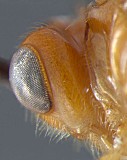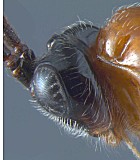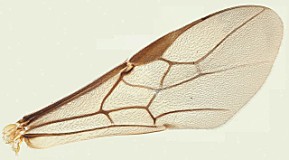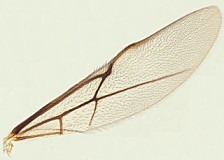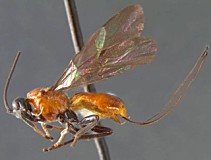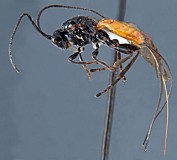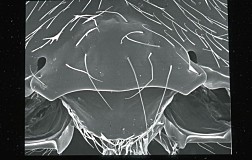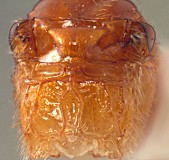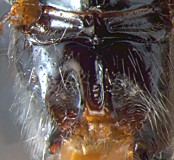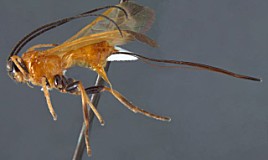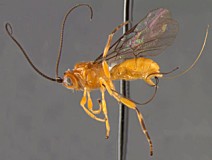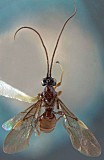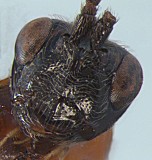Doryctobracon Enderlein, 1920
Synonym: Parachasma Fischer, 1967 (Fischer 1977).
In many of the publications prior to 1980, the species of Doryctobracon were placed either in the genus Opius or in the genus Biosteres. The name Parachasma was also used for about 10 years prior to the discovery by Fischer (1977) that Doryctobracon, previously included in a different subfamily, was the same as Parachasma.Unless you are already on this page, considerably more information on species groups and use in biological control can be found on the Doryctobracon page (and associated links) of the Paroffit website page: http://mx.speciesfile.org/projects/8/public/public_content/show/13335?content_template_id=88
Key to species of Doryctobracon reared from fruit-infesting Tephritidae
1. Propodeum areolate, as in Fig. 1. (go to 2)
1a. Propodeal sculpture reduced to two apical ridges, as in Fig. 2. Propodeum never with complete median areola. (go to 6)
2. Fore wing yellow basally and black at the tip (Fig. 3). (go to 3)
2a. Fore wing either uniformly clear (hyaline) (Figs 4, 5) or uniformly darkened (infumate). (go to 4)
3. Head and hind femur mostly black (see Fig. 3): The top half of the head is almost always black, and sometimes the entire head is black. D. zeteki (Muesebeck)
3a. Head and hind femur mostly or entirely yellow to yellow-orange. This species is otherwise quite similar to D. zeteki. D. auripennis (Muesebeck)
4. Legs darker. Fore and middle tibia and femur dark brown to black. Known only from Florida. Doryctobracon anastrephilus (Marsh)
4a. Legs not as dark. Fore and middle tibiae yellow or yellow-orange. Widely distributed. (go to 5)
5. Fore wing clear (hyaline) (Figs 4, 5). Doryctobracon areolatus (Szépligeti)
5a. Fore wing darkened (infumate). Doryctobracon fluminensis (Costa Lima)
6. Stigma of fore wing brightly colored (yellow) (Fig. 6). Doryctobracon brasiliensis (Szépligeti)
6a. Stigma of fore wing dark; wings do not have yellow markings. (go to 7)
7. Head and mesosoma (thorax + propodeum) almost always black and remainder of abdomen (beyond propodeum) almost always bright yellow (Fig. 7). Primarily attacks Toxotrypana curvicauda Gerstaecker in papaya and thus this species is also identifiable on the basis of the host and host plant from which it is reared. Doryctobracon toxotrypanae (Muesebeck)
7a. Thorax and abdomen usually orange, red, or reddish-orange (Fig. 8). (go to 8)
8. Widely distributed, occurring from northern Mexico to northern Argentina. Doryctobracon crawfordi (Viereck)
8a. Known only from the island of Trinidad. Otherwise difficult to distinguish from D. crawfordi. There are slight differences in the density of setae on the frons (behind the antennal bases), with the frons being more densely hairy in D. crawfordi. The midline of the propodeum (between the parallel ridges) is also sometimes more deeply impressed in D. crawfordi than in D. trinidadensis, and forms a distinct groove. Doryctobracon trinidadensis (Gahan)
Group 1
This group includes species with propodeal sculpture areolate. Fig. 1 shows typical sculpture in this group.
Group Members:
Doryctobracon zeteki (Muesebeck)
Doryctobracon auripennis (Muesebeck)
Doryctobracon anastrephilus (Marsh)
Doryctobracon areolatus (Szépligeti)
Doryctobracon fluminensis (Costa Lima)
These five species can be separated into two subgroups based on the color pattern of the wings. In two of the species, D. auripennis and D. zeteki, the fore wing is yellow basally and black at the tip (Fig. 3). In the other three species, the fore wing is either uniformly clear (hyaline) (Fig. 4) or uniformly darkened (infumate).
Group 2
This group includes species with propodeal sculpture reduced to two apical ridges. Fig. 2 shows the typical propodeal sculpture in this group.
Group Members:
Doryctobracon brasiliensis (Szépligeti)
Doryctobracon toxotrypanae (Muesebeck)
Doryctobracon crawfordi (Viereck)
Doryctobracon trinidadensis (Gahan)
Doryctobracon brasiliensis is readily separated from the other three species in this group by the brightly colored (yellow) stigma of the fore wing (Fig. 6). The other three species have the stigma dark and the wings do not have yellow markings. However, among the few species of Doryctobracon for which there are no host records, there is another one with a bright yellow stigma known only from one specimen collected in Tucuman, Argentina. This is Doryctobracon homosoma (Fischer). Identification of any Doryctobracon material reared from that region of Argentina would need to take this into account.
Males of the species of Doryctobracon examined thus far share with Fopius and Diachasmimorpha paired Hagen’s glands with exceptionally long, thin filaments. These glands occupy much of the lateral portions of the abdominal cavity. For further comments about these glands, see Diachasmimorpha page.

